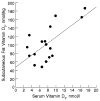Vitamin D(3) in fat tissue
- PMID: 18338271
- PMCID: PMC2839878
- DOI: 10.1007/s12020-008-9051-4
Vitamin D(3) in fat tissue
Abstract
The literature describing vitamin D content of fat tissue is extremely limited. We conducted a pilot study that measured the concentrations of vitamin D(3) in the fat tissue and serum of obese adults. These measurements were performed using a new liquid chromatography mass spectrometry (LC/MS) method. The objectives of this study were: to measure and report the vitamin D(3) concentration in serum and subcutaneous fat samples from obese individuals and to examine the association of vitamin D(3) in fat with vitamin D(3) in serum. This cross-sectional study was conducted in 17 obese men and women who were scheduled to undergo gastric bypass surgery. The mean vitamin D(3) concentration in subjects' subcutaneous fat tissue samples was 102.8 +/- 42.0 nmol/kg. The mean vitamin D(3) concentration in serum was 7.78 +/- 3.99 nmol/l. Vitamin D(3) concentrations of fat tissue and serum were positively correlated (r = 0.68, P = 0.003). Consistent with previous findings in obese subjects, subjects in this study had suboptimal vitamin D status as demonstrated by a mean 25-hydroxyvitamin D concentration of 43.3 +/- 15.4 nmol/l. In conclusion, fat tissue vitamin D(3) can be measured by LC/MS and is detectable in obese subjects with suboptimal vitamin D status. Compatible with the long-standing concept that fat tissue is a storage site for vitamin D, fat tissue and serum vitamin D(3) concentrations were positively correlated.
Figures
References
-
- Mawer EB, Backhouse J, Holman CA, Lumb GA, Stanbury SW. The distribution and storage of vitamin D and its metabolites in human tissues. Clin Sci. 1972;43:413–431. - PubMed
-
- Lawson DE, Douglas J, Lean M, Sedrani S. Estimation of vitamin D3 and 25-hydroxyvitamin D3 in muscle and adipose tissue of rats and man. Clin Chim Acta. 1986;157:175–181. - PubMed
-
- Brouwer DA, van Beek J, Ferwerda H, et al. Rat adipose tissue rapidly accumulates and slowly releases an orally-administered high vitamin D dose. Br J Nutr. 1998;79:527–532. - PubMed
-
- Liel Y, Ulmer E, Shary J, Hollis BW, Bell NH. Low circulating vitamin D in obesity. Calcif Tiss Int. 1988;43:199–201. - PubMed
Publication types
MeSH terms
Substances
Grants and funding
LinkOut - more resources
Full Text Sources
Other Literature Sources


